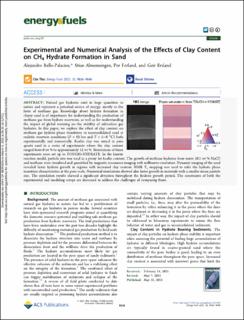Experimental and Numerical Analysis of the Effects of Clay Content on CH4 Hydrate Formation in Sand
Journal article, Peer reviewed
Published version

Åpne
Permanent lenke
https://hdl.handle.net/11250/2986134Utgivelsesdato
2021Metadata
Vis full innførselSamlinger
Sammendrag
Natural gas hydrates exist in large quantities in nature and represent a potential source of energy, mostly in the form of methane gas. Knowledge about hydrate formation in clayey sand is of importance for understanding the production of methane gas from hydrate reservoirs, as well as for understanding the impact of global warming on the stability of subsurface gas hydrates. In this paper, we explore the effect of clay content on methane gas hydrate phase transitions in unconsolidated sand at realistic reservoir conditions (P = 83 bar and T = 5–8 °C) both experimentally and numerically. Kaolin clay was mixed in pure quartz sand in a series of experiments where the clay content ranged from 0 wt % to approximately 12 wt %. Simulations of these experiments were set up in TOUGH+HYDRATE. In the kinetic reaction model, particle size was used as a proxy for kaolin content. The growth of methane hydrates from water (0.1 wt % NaCl) and methane were visualized and quantified by magnetic resonance imaging with millimeter resolution. Dynamic imaging of the sand revealed faster hydrate growth in regions with increased clay content. NMR T2 mapping was used to infer the hydrate phase transition characteristics at the pore scale. Numerical simulations showed also faster growth in materials with a smaller mean particle size. The simulation results showed a significant deviation throughout the hydrate growth period. The constraints of both the experimental and modeling setups are discussed to address the challenges of comparing them.
